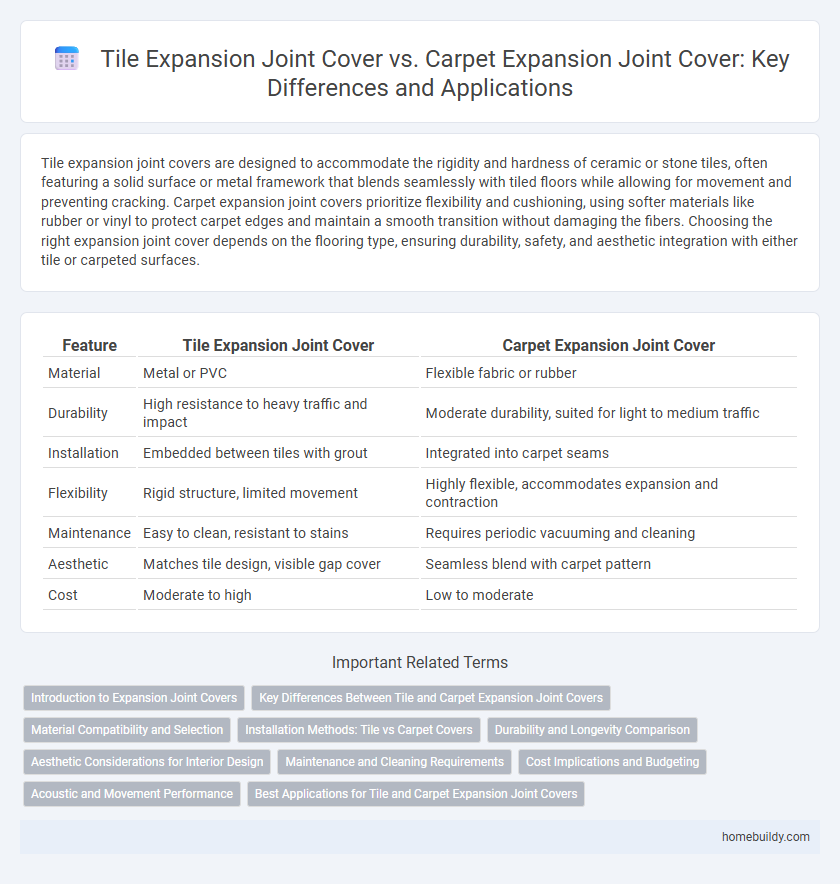Tile expansion joint covers are designed to accommodate the rigidity and hardness of ceramic or stone tiles, often featuring a solid surface or metal framework that blends seamlessly with tiled floors while allowing for movement and preventing cracking. Carpet expansion joint covers prioritize flexibility and cushioning, using softer materials like rubber or vinyl to protect carpet edges and maintain a smooth transition without damaging the fibers. Choosing the right expansion joint cover depends on the flooring type, ensuring durability, safety, and aesthetic integration with either tile or carpeted surfaces.
Table of Comparison
| Feature | Tile Expansion Joint Cover | Carpet Expansion Joint Cover |
|---|---|---|
| Material | Metal or PVC | Flexible fabric or rubber |
| Durability | High resistance to heavy traffic and impact | Moderate durability, suited for light to medium traffic |
| Installation | Embedded between tiles with grout | Integrated into carpet seams |
| Flexibility | Rigid structure, limited movement | Highly flexible, accommodates expansion and contraction |
| Maintenance | Easy to clean, resistant to stains | Requires periodic vacuuming and cleaning |
| Aesthetic | Matches tile design, visible gap cover | Seamless blend with carpet pattern |
| Cost | Moderate to high | Low to moderate |
Introduction to Expansion Joint Covers
Expansion joint covers protect building structures by accommodating movement caused by thermal changes, seismic activity, or structural shifts. Tile expansion joint covers are designed to integrate seamlessly with tile flooring, offering durability and resistance to moisture and heavy foot traffic. Carpet expansion joint covers, conversely, provide flexibility and a smooth transition for carpeted surfaces while minimizing disruption to the flooring pattern and maintaining comfort underfoot.
Key Differences Between Tile and Carpet Expansion Joint Covers
Tile expansion joint covers are designed to accommodate rigid surfaces, featuring a hard, durable profile that blends seamlessly with tile flooring while allowing for substrate movement. Carpet expansion joint covers incorporate flexible, cushioned materials that integrate with textile flooring and provide sound absorption and comfort, accommodating the softer, more pliable nature of carpet. The primary differences lie in material composition, flexibility, and compatibility with flooring types, where tile covers prioritize rigidity and seamless integration, and carpet covers emphasize flexibility and cushioning.
Material Compatibility and Selection
Tile expansion joint covers are specifically designed to accommodate the rigidity and hardness of ceramic, porcelain, or stone tiles, typically made from metal or rigid PVC to match tile thickness and provide seamless integration. Carpet expansion joint covers utilize flexible materials such as rubber or vinyl to adapt to softer carpeted surfaces, ensuring durability without compromising the carpet's texture and cushioning. Selecting the appropriate cover depends on substrate compatibility, load requirements, and aesthetic cohesion with the flooring material for optimal expansion joint performance.
Installation Methods: Tile vs Carpet Covers
Tile expansion joint covers require a methodical installation process involving embedding the cover into mortar or grout for seamless integration with surrounding tiles, ensuring durability and alignment with the tile surface. Carpet expansion joint covers typically utilize adhesive backing or mechanical fastening, allowing flexibility to accommodate carpet thickness and reduce flooring irregularities. Both installation methods prioritize securing the cover while maintaining smooth transitions and accommodating material-specific movements.
Durability and Longevity Comparison
Tile expansion joint covers typically offer superior durability due to their resistance to heavy foot traffic, moisture, and wear, making them ideal for high-traffic commercial spaces. Carpet expansion joint covers, while providing a seamless aesthetic and sound-dampening benefits, generally demonstrate less longevity as they are more prone to abrasion, staining, and fiber breakdown over time. The choice between tile and carpet expansion joint covers should consider the specific environmental demands and maintenance capacity to optimize lifespan and performance.
Aesthetic Considerations for Interior Design
Tile expansion joint covers offer a seamless, polished appearance that integrates smoothly with ceramic or porcelain surfaces, enhancing the uniformity of high-traffic commercial spaces. Carpet expansion joint covers provide a softer, textured finish that complements textile flooring, promoting warmth and acoustic comfort in office or residential interiors. Selecting the appropriate cover depends on the desired aesthetic cohesion, durability requirements, and the surrounding design elements for optimal visual harmony.
Maintenance and Cleaning Requirements
Tile expansion joint covers require less frequent cleaning due to their smooth, hard surface that resists dirt accumulation and is easily wiped down with mild detergents. Carpet expansion joint covers demand regular vacuuming and occasional deep cleaning to prevent dirt and debris from embedding in the fibers, which can lead to wear and discoloration. Maintenance of tile covers is typically more straightforward, whereas carpet covers require more consistent attention to preserve appearance and functionality.
Cost Implications and Budgeting
Tile expansion joint covers generally involve higher material and installation costs due to the need for durable, rigid components that can withstand heavy foot traffic and potential movement. Carpet expansion joint covers are typically more cost-effective, offering easier installation and lower maintenance expenses while providing flexibility in design. Budgeting should account for long-term durability in tile systems versus initial savings with carpet options, balancing upfront investment against lifespan and repair frequency.
Acoustic and Movement Performance
Tile expansion joint covers offer superior movement accommodation due to their rigid construction, effectively managing thermal expansion and contraction without compromising structural integrity. Carpet expansion joint covers excel in acoustic performance by providing sound absorption and reducing noise transmission across joints, enhancing overall room acoustics. The choice between tile and carpet expansion joint covers depends on balancing the need for robust movement performance versus improved acoustic insulation in the application space.
Best Applications for Tile and Carpet Expansion Joint Covers
Tile expansion joint covers are best suited for hard surface floors where durability and water resistance are critical, such as in commercial kitchens or bathrooms. Carpet expansion joint covers excel in office environments and hotels where aesthetics and sound absorption are important, providing a seamless transition while protecting the flooring from damage. Choosing the right joint cover depends on floor type, traffic intensity, and maintenance requirements.
Tile expansion joint cover vs Carpet expansion joint cover Infographic

 homebuildy.com
homebuildy.com